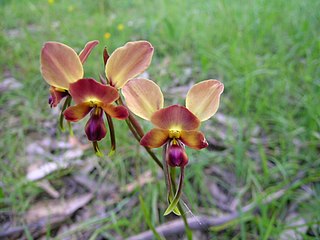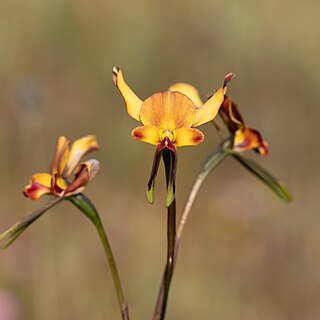
Diuris pardina, commonly known as the leopard orchid or leopard doubletail is a species of orchid which is endemic to south-eastern Australia. It has two or three grass-like leaves and up to ten yellow flowers with reddish-brown marks and blotches.
Diuris maculata, commonly known as the spotted doubletail, is a species of orchid endemic to New South Wales. It has up to two or three folded leaves and a flowering stem with up to eight yellow flowers with brown to blackish markings. It is similar to D. pardina which has darker flowers with larger brown markings.

Diuris protena, commonly known as northern golden moths, is a species of orchid which is endemic to Victoria. It has a tuft of between four and eight leaves at the base and up to three mostly yellow flowers with a few light-coloured marks. It is classed as "endangered" in Victoria.

Diuris orientis, commonly called the wallflower orchid or eastern wallflower orchid, is a species of orchid which is endemic to eastern Australia. Like others in the genus Diuris, it has two ear-like petals and is similar to the common donkey orchid of Western Australia with which it has been confused. This species is found in New South Wales, Victoria, South Australia and Tasmania and its stalk-like petal "claw" is shorter in than those of D. corymbosa.

Diuris concinna, commonly called the elegant donkey orchid, is a species of orchid which is endemic to the south-west of Western Australia. It has up to five linear leaves at its base and up to five pale yellow flowers with brown markings. It is found along the south coast, often growing in areas that are flooded in winter and flowering more prolifically after fire the previous summer.
Diuris eburnea is a species of orchid that is endemic to the south-west of Western Australia. It has between four and six linear leaves and up to eight pale yellow to cream-coloured flowers with reddish markings. It is only known from near the Arrowsmith River north of Eneabba.
Diuris exitela, commonly called the Mount Moffat doubletail, is a species of orchid which is endemic to central western Queensland. It has two linear leaves at its base, up to twelve bright yellow flowers with dark brown markings and grows on sandstone cliffs and ridges.
Diuris micrantha, commonly called the dwarf bee orchid or tiny bee orchid, is a rare species of orchid which is endemic to the south-west of Western Australia. It has four to six linear leaves at its base and up to six yellow flowers with reddish brown markings. It grows in swampy places south of Perth.
Diuris luteola, commonly called the northern doubletail, is a species of orchid which is endemic to Queensland. It has a single linear leaf at its base and up to six pale yellow flowers with a few brown markings. It grows in shallow, stony soil on tablelands in eastern parts of the state.
Diuris ochroma, commonly known as pale goat orchid, or pale golden moths is a species of orchid that is endemic to south-eastern continental Australia. It has three or four leaves at its base and up to four slightly drooping pale yellow flowers with dark reddish purple streaks. It is an uncommon species found in two disjunct populations, in higher parts of each of New South Wales and Victoria.

Diuris oporina, commonly called the autumn donkey orchid or northern white donkeys tails is a species of orchid that is endemic to Queensland. It has a single tapering, linear leaf at its base and up to ten white flowers with mauve to purple markings. It grows in the drier parts of the tablelands in Far North Queensland.

Diuris brachyscapa, commonly known as western wheatbelt donkey orchid, is a species of orchid that is endemic to the south-west of Western Australia. It has two or three linear leaves and a flowering stem with up to four pale yellow flowers with brown markings.
Diuris brevis, commonly known as short-nosed donkey orchid, is a species of orchid that is endemic to a restricted area in the south-west of Western Australia. It has two or three linear leaves and a flowering stem with up to four small yellow and brown flowers with a short labellum.

Diuris brockmanii, commonly known as south coast donkey orchid, is a species of orchid that is endemic to the south-west of Western Australia. It has two or three linear leaves and a flowering stem with up to ten yellow flowers with reddish-brown markings.
Diuris brevifolia is a species of orchid that is endemic to South Australia. It usually has one or two grass-like leaves and a flowering stem with up to five bright yellow and reddish-brown flowers with purple stalks.
Diuris cruenta, commonly known as Kemerton donkey orchid, is a species of orchid that is endemic to the south-west of Western Australia. It has two or three linear leaves and a flowering stem with up to seven pale yellow and reddish-brown flowers, and is similar to D. tinctoria.

Diuris goonooensis, commonly known as Goonoo donkey orchid or western donkey orchid, is a species of orchid that is endemic to western New South Wales. It has one or two linear leaves at its base and up to eight yellow flowers with brown markings on each part of the flower.

Diuris hazeliae, commonly known as yellow granite donkey orchid, is a species of orchid that is endemic to the south-west of Western Australia. It has between two and four linear leaves and up to six bright yellow and reddish-brown flowers.
Diuris insignis, commonly known as dark bee orchid, is a species of orchid that is endemic to the south-west of Western Australia. It has between two and six narrowly linear to thread-like leaves and up to five yellow flowers with many dark red markings.
Diuris inundata is a species of orchid that is endemic to south-eastern continental Australia. It usually has between three and six grass-like leaves and a flowering stem with one or two pale yellow to buttercup yellow flowers with a few rusty-red specks.









